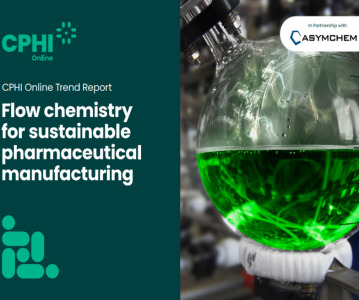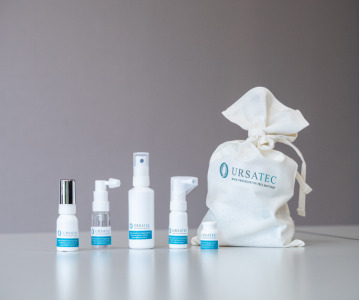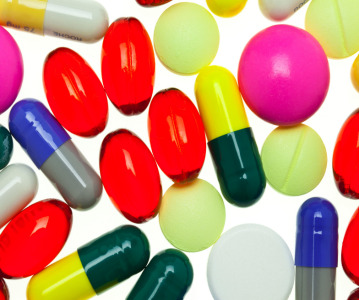Biocatalysis: An Indispensable Tool for Synthesis of Active Pharmaceutical Ingredients

Biocatalytic processing offers a wealth of advantages and should be evaluated during early-stage drug development for its potential to improve yields, increase efficiency, and support greener manufacturing.
Author: Benzion Dolitzky, PhD, VP R&D at Wavelength Pharmaceuticals
Biocatalysis is widely recognized to be one of the most powerful tools for organic synthesis due to its green credentials and its exquisite regio-, enantio-, and stereoselectivities. In recent years, it has benefited significantly from the development of a broad range of enabling technologies, leading biocatalysis to become an established methodology for efficient, sustainable manufacturing, especially within the drug development industry. A multitude of enzymes is now utilized for generating active pharmaceutical ingredients (APIs) and intermediates for their production, with such reagents offering numerous advantages compared to using traditional metal catalysts. One of the main benefits of biocatalysis is that it increases conversion efficiency for significantly higher yields with fewer by-products, equating to faster and more cost-effective production. By integrating biocatalysis into ongoing and newly launched projects, Wavelength Pharmaceuticals has shown that it is possible to reduce overall costs by as much as 30%. For these reasons, many pharmaceutical companies are choosing to evaluate biocatalytic processes during early-stage drug development to avoid missing opportunities for capitalizing on these gains.
Biocatalytic processes leverage fundamental enzyme characteristics
Enzymes play a pivotal role in the catalysis of many different bio-transformation reactions in nature, typically exerting their effects under mild, neutral conditions. This has led to them being evaluated as alternatives to traditional metal catalysts for driving various chemical transformations, where they have demonstrated huge success. Some of the first enzyme classes used as tools for organic synthesis were hydrolases (e.g. amidases, esterases, and lipases), alcohol dehydrogenases, and ketoreductases. These have since been joined by many other types of enzyme, including transaminases, oxidases, nitrilases, aldolases, and ammonia lyases, all of which perform distinct functions.
An inherent advantage of using enzymes for synthetic chemistry is that they increase regio-, enantio-, and stereoselectivity for more efficient conversion of substrate to product. Additionally, because only small quantities of enzyme are required to catalyze a reaction, integrating them into production workflows can dramatically reduce raw material costs. In turn, these properties of enzymes translate to lower overall costs for manufacturing the final product. Further savings are realized through elimination of complicated protection/deprotection and activation steps, removal of the need for multiple, time-consuming purifications, and higher atom utilization to increase the percentage of reactants that become useful products.
Enabling technologies have increased the scope of biocatalysis
The development of various enabling technologies has been critical in expanding the potential of biocatalytic processing, as well as in promoting its uptake across the pharmaceutical industry. Improved gene mining techniques have permitted previously uncharacterized gene clusters to be discovered, while advances in heterologous expression and production have allowed the encoded enzymes to rapidly be scaled up and evaluated as tools for organic synthesis.
Building on this progress, recombinant technologies have been key to optimizing the performance of biocatalytic reagents, for example by facilitating a reduction in the amount of enzyme needed to drive a reaction while at the same time increasing the yield. It has also been possible to prepare enzymes that can function effectively in organic solvents, thereby dramatically increasing the number of reactions possible. Other innovative technology developments have made immobilizing enzymes on solid supports like glass, silicon, or any other polymer more efficient. This not only makes it easier to remove enzyme residues from the desired product, but also ensures valuable high turnover enzymes can be reused multiple times without compromising their activity.
Advantages of biocatalytic processing
Biocatalytic processing offers many advantages over using conventional metal catalysts. The superior enantio- and regioselectivity of enzymes results in higher yields of purer product – typically comprising just a single enantiomer that has been modified on only a specific site. Moreover, the improved stereoselectivity further enhances product purity by ensuring that only one stereoisomer reacts where a mixture of stereoisomers is present. Atom utilization is also better with biocatalysis; where two or more moieties on the same molecule have the capacity to undergo a particular reaction, biocatalytic processing guarantees that one site is consistently chosen over the other. The incredible selectivity of enzyme catalysts consequently simplifies workflows by generating fewer by-products and reducing impurities to markedly decrease the total number of synthetic steps required.

Another critically important benefit of biocatalytic processes is that they are far more eco-efficient than conventional methods. This is because enzymes, being originally derived from natural products, generally perform best under mild (often ambient) conditions. While reactions requiring the use of metal catalysts may necessitate heating to temperatures of 160oC, and/or cooling to -60oC or lower, enzyme-catalyzed reactions instead run at temperatures in the region of ~10 - 40oC. This so-called ‘green chemistry’ is much safer than metal-catalyzed approaches and can save vast quantities of reagents, consumables, organic solvents, and energy over the lifetime of a project to dramatically reduce waste and environmental burden. Biocatalysis also helps to avoid pollution and reduce global environmental impact as it helps minimize the use of rare metals which often require extensive mining and processing operations.
Importance of evaluating biocatalytic processes during development
With the chemical industry being one of the most polluting, global efforts are heavily focused on developing a more sustainable and greener footprint. The growing use of biocatalysis in pharmaceutical chemistry promises to deliver on this need, while also offering substantial cost savings and faster time to market for urgently needed therapeutics. However, to leverage these benefits, it is vital that biocatalytic processes be evaluated as early in the drug development life cycle as possible. Fortunately, the growing availability of diverse kits of enzyme classes can facilitate this process, allowing researchers to screen enzymes/biocatalysts in much the same way as traditional screening of metal catalysts is performed.
A major advantage of identifying suitable biocatalysts early on is that it provides ample opportunity for optimization. For example, by using molecular modeling tools to achieve rapid de novo design of new enzymes, it may be possible to increase activity, enhance temperature stability, or improve solvent compatibility to better align with the process in question. As further tools are created to improve biocatalyst development, these can likewise be assessed for their capacity to add value to a project.
Expedite biocatalysis development by partnering with an API CDMO
Although biocatalysis is globally acknowledged to be a valuable means of ensuring greener, more sustainable manufacturing, its implementation has reached stasis after increasing steadily for the past 10 - 15 years. A possible reason for this is that developments within the biocatalysis field have fast outpaced existing knowhow, leaving some pharmaceutical companies unaware of the vast range of options available. Keeping abreast of both current and emerging developments within the field of biocatalytic processing is key when it comes to maintaining a competitive edge.
One way of leveraging the many benefits of biocatalysis is to partner with an API CDMO offering comprehensive expertise and experience in developing and implementing such technology in GMP commercial production. With an up-to-date working knowledge of both established biocatalytic processes and the very latest techniques, a trusted API CDMO provider can offer a suite of technical capabilities, backed by highly trained personnel and a proven track record of consistent quality and regulatory compliance.
Exploring biocatalysis options at the start of a project is a pragmatic operational strategy to achieve the right product, at the right quality, with exceptional efficiency. Such investment is by no means prohibitive and can reap substantial rewards that include shorter development timelines, lower costs, faster time to market, and game changing technological advantage for sustainable competitive edge.

Related News
-
Sponsored Content CPHI Online Trend Report: How can flow chemistry help businesses achieve their sustainability goals?
In our latest CPHI Online Trend Report, we partner with Asymchem to understand the innovative potential of flow chemistry for API manufacturing, especially in regards to meeting sustainability goals. -
Sponsored Content Ashwagandha and Herbal Medicines: Pharma’s Next Opportunity
Herbal medicines and nutraceuticals have seen a surge in interest since the onset of the COVID-19 pandemic. Driven by patient interest in prioritising personalised and integrative medicines, the herbal ingredients industry is now faced with concerns pe... -
Sponsored Content Discover Our Organic Mineral Salts as APIs
Discover the range of organic mineral salts that serve as Active Pharmaceutical Ingredients available from Dr. Paul Lohmann®. -
Sponsored Content CPHI Podcast Series: Ursatec – celebrating 30 years of pioneering preservative free
In the latest episode of the CPHI Podcast Series, Digital Editor Lucy Chard spoke with Dominik Rocchi of Ursatec. -
Sponsored Content How healthcare trends inform dosage forms
Capsules encompass one of the most popular solid oral dosage forms for pharmaceutical products, with the global empty capsule market predicted to rise to USD $3.7 billion by 2026. The growth in the capsule market can be partly attributed to the many op... -
Sponsored Content Pharma Trend Outlook: Pharma 4.0 and Industry Resilience
Download our 2023 Pharma Trends Outlook report to discover the trends set to shape the pharmaceutical landscape in the new year, with expert opinions and insight from across the pharmaceutical value chain. -
Sponsored Content CPHI Podcast Series: Key Considerations in Selecting the Right CMO Partner
In this month's episode we hear from Jayna Blake, Senior Project Manager for Technical Programs at Baxter BioPharma Solutions, on key considerations for successful CMO selection. -
Sponsored Content Size doesn’t matter: How smaller deals are shaping healthcare M&A
Several mega-deals have made a splash in the pharma and life sciences industries over recent years – from AstraZeneca’s acquisition of Alexion for $39 billion to Gilead Sciences’ $21 billion purchase of Immunomedics. With am...
Recently Visited
Position your company at the heart of the global Pharma industry with a CPHI Online membership
-
Your products and solutions visible to thousands of visitors within the largest Pharma marketplace
-
Generate high-quality, engaged leads for your business, all year round
-
Promote your business as the industry’s thought-leader by hosting your reports, brochures and videos within your profile
-
Your company’s profile boosted at all participating CPHI events
-
An easy-to-use platform with a detailed dashboard showing your leads and performance

.png)





